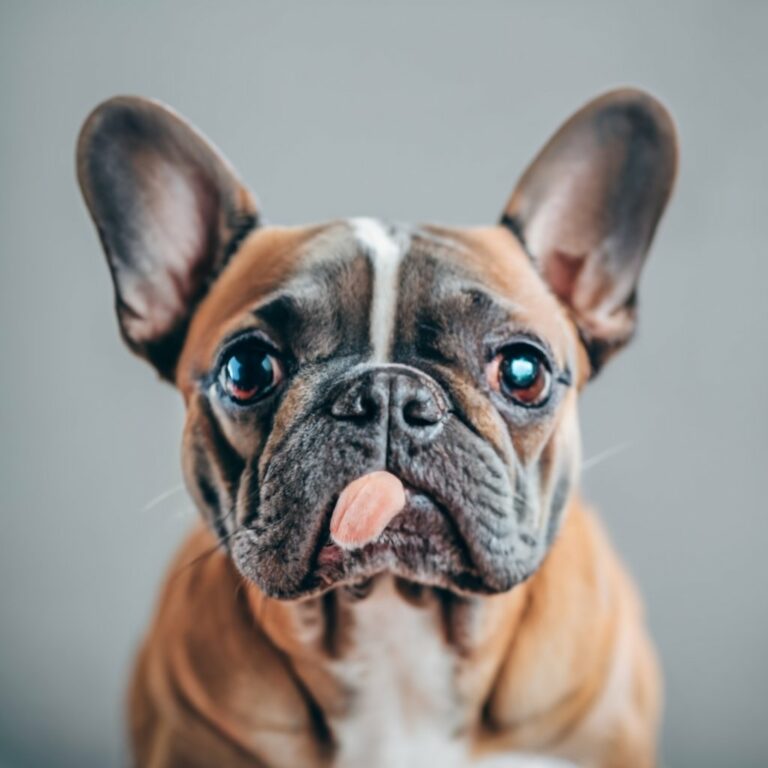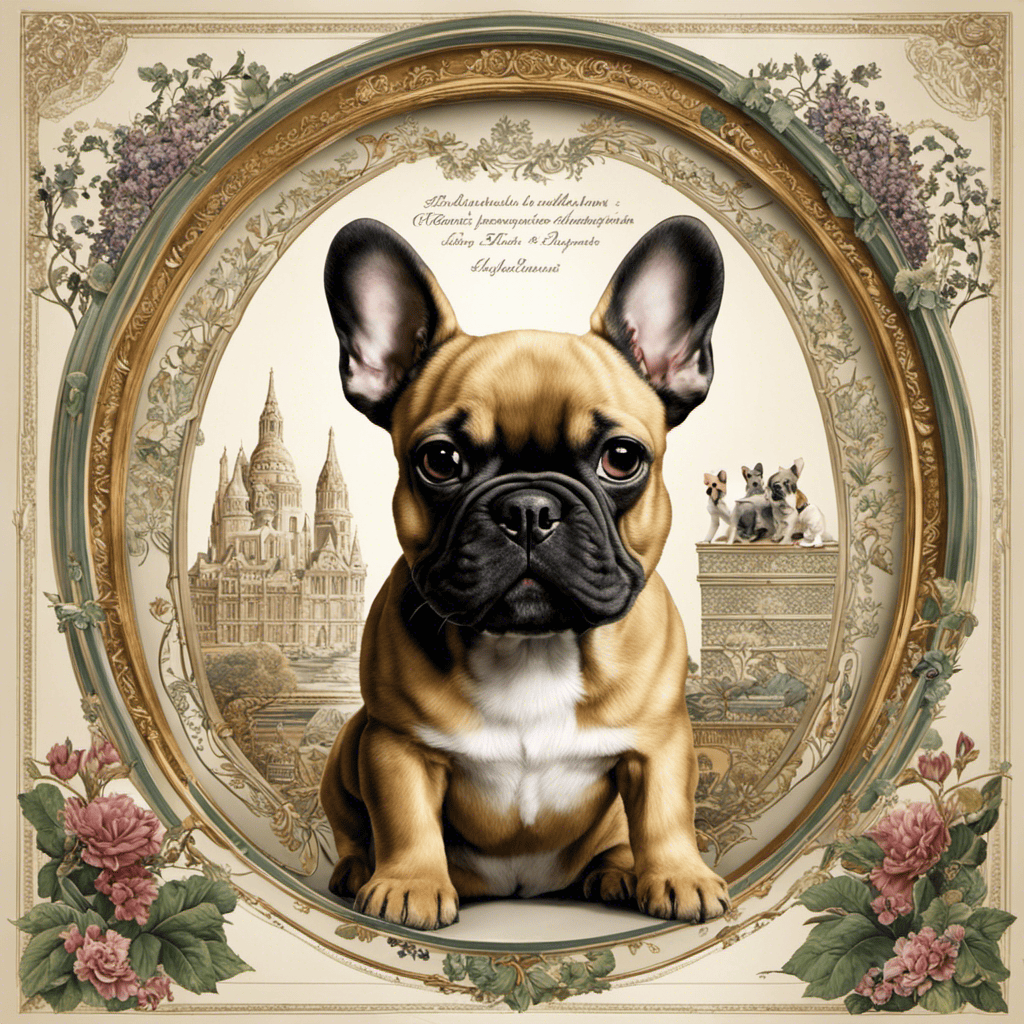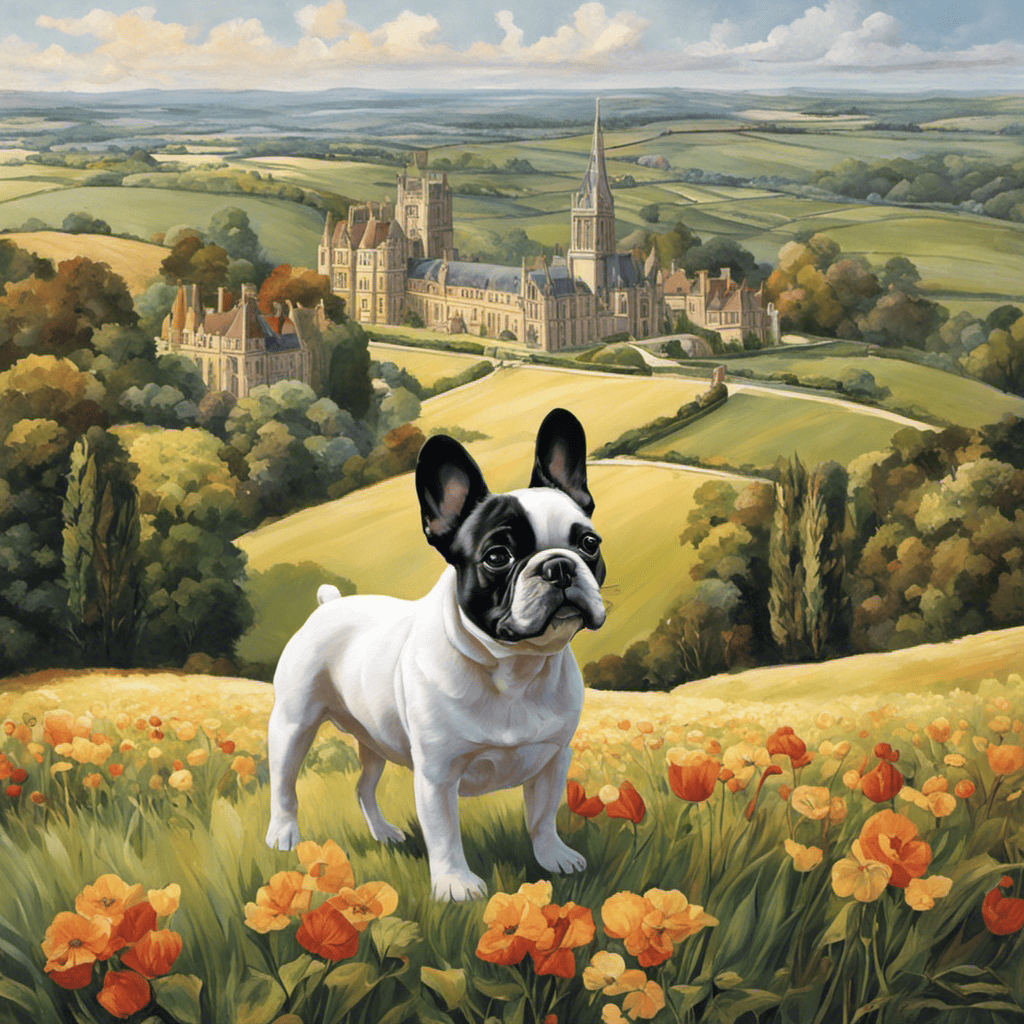I’ve uncovered the fascinating origins of the French Bulldog breed, and let me tell you, it’s a story that will make your heart skip a beat.
From the bustling streets of 19th century France to the opulent homes of English aristocrats, this breed has captivated the world with its charm and uniqueness.
Join me as I delve into the history, tracing the lineage from Bulldogs in the French ratting trade to the influence of the Toy Bulldog.
Get ready to be amazed by the journey of the French Bulldog.
Key Takeaways

- The French Bulldog breed originated in England in the early 1800s and was initially created as a smaller version of the English Bulldog.
- The breed gained popularity among lace workers in Nottingham and was brought to France during the Industrial Revolution.
- Genetic analysis shows that the French Bulldog has similarities with the English Bulldog, Pug, and Terrier breeds, which contribute to its unique characteristics.
- Bulldogs played a crucial role in controlling the rodent population in urban areas and preventing the spread of diseases, thanks to their tenacity, strength, and agility.
The Ancestry of the French Bulldog

I’m fascinated by the ancestry of the French Bulldog and how it has evolved over time. Ancestry research reveals that the French Bulldog has a rich history, with its roots dating back to the early 1800s in England. The breed was initially created as a smaller version of the English Bulldog and was popular among lace workers in Nottingham. These lace workers migrated to France during the Industrial Revolution, bringing their beloved dogs with them. In France, the breed gained popularity and underwent further refinement.
Genetic makeup plays a crucial role in understanding the ancestry of the French Bulldog. DNA analysis has shown that the breed shares genetic similarities with the English Bulldog, Pug, and Terrier breeds. These genetic influences contribute to the unique characteristics of the French Bulldog, such as its sturdy build, compact size, and distinctive bat-like ears.
Over the years, breeders have carefully selected and bred French Bulldogs to maintain their desired traits. Today, the breed is recognized for its friendly and affectionate temperament, making it a popular choice among dog lovers worldwide.
The Role of Bulldogs in the French Ratting Trade

I’ve always been intrigued by the role Bulldogs played in the French ratting trade, as they were often trained to help control the rodent population in urban areas. Bulldogs were highly valued for their tenacity, strength, and agility, making them ideal for this task. To better understand their involvement in the ratting trade, let’s explore the breeding practices and ratting techniques associated with Bulldogs during that time.
| Breeding Practices | Ratting Techniques | Role in the French Ratting Trade |
|---|---|---|
| Selective breeding was common among breeders to enhance the Bulldogs’ physical attributes and hunting instincts. This involved pairing dogs with desirable traits, such as a strong jaw and a compact, muscular body. The goal was to create a breed that was well-suited for ratting. | Ratting techniques involved the use of Bulldogs’ natural hunting instincts. These dogs were trained to locate and capture rats in urban areas. They would use their strong jaw to catch and hold the rodents, preventing their escape. Additionally, Bulldogs were known for their determination and fearlessness, which made them excellent at pursuing and capturing rats in tight spaces. | Bulldogs played a crucial role in the French ratting trade. Their unique combination of physical traits and hunting instincts made them highly effective in controlling the rodent population in urban areas. Their small size and agility allowed them to navigate narrow spaces, while their strong jaw ensured a firm grip on the rats. With their help, the French were able to keep the rat population in check, preventing the spread of diseases and protecting their crops and food stores. |
Bulldog breeding practices and ratting techniques were key factors in the success of the French ratting trade. This unique partnership between humans and Bulldogs allowed for efficient and effective rat control, benefiting both urban areas and the agricultural industry. The Bulldogs’ contribution to the ratting trade showcases their versatility and adaptability, traits that continue to be valued in the breed today.
The Influence of the Toy Bulldog on the French Bulldog Breed

As a researcher, I’m fascinated by the influence of the Toy Bulldog on the French Bulldog breed, as it highlights the significance of crossbreeding and the impact it can have on shaping a breed’s characteristics.
The Toy Bulldog, also known as the Miniature Bulldog, played a crucial role in the development of the French Bulldog we know today. During the late 19th century, when the breed was still in its early stages, breeders sought to refine its appearance and temperament. They achieved this by introducing the Toy Bulldog into the breeding program. The Toy Bulldog was a smaller version of the English Bulldog, with a more compact body and a friendlier disposition. By incorporating its genes into the French Bulldog bloodline, breeders were able to enhance the breed’s temperament, making it more affectionate and sociable.
The influence of Toy Bulldog breeding on the French Bulldog’s temperament can’t be understated. Today, French Bulldogs are known for their friendly and outgoing nature, traits that can be traced back to the early crossbreeding efforts. The Toy Bulldog’s contribution to the French Bulldog breed is a testament to the importance of carefully selecting and introducing new genetic lines to shape a breed’s characteristics.
The French Bulldog’s Journey From France to England

I discovered how the French Bulldog breed thrived as it journeyed from France to England, adapting to its new surroundings and becoming a beloved companion for many. The influence of the Industrial Revolution on the French Bulldog breed cannot be underestimated. As the Industrial Revolution brought about a shift from rural to urban living, the demand for smaller dogs increased. The French Bulldog, with its compact size and friendly temperament, became the perfect companion for the urban dwellers of England.
The impact of World War I on the French Bulldog’s popularity in England was significant. During the war, many soldiers brought French Bulldogs back to England as mascots and companions. This increased exposure to the breed and its charming personality led to a surge in popularity. After the war, the French Bulldog became a symbol of resilience and loyalty, further solidifying its place in the hearts of the English people.
| Industrial Revolution | World War I |
|---|---|
| Increased demand for | French Bulldogs brought |
| smaller dogs | back as mascots and |
| companions by soldiers | |
| ————————– | ————————— |
| Shift from rural to | Surge in popularity |
| urban living | after the war |
| ————————– | ————————— |
The French Bulldog’s Rise to Popularity in the 19th Century

Interestingly, the French Bulldog’s rise to popularity in the 19th century can be attributed to both its adorable appearance and its friendly nature. This breed quickly captured the hearts of dog enthusiasts and became a favorite among the upper class.
Today, the French Bulldog continues to make an impact on modern-day dog shows and plays a significant role in the fashion industry.
In the world of dog shows, the French Bulldog has gained immense popularity. With its compact size, distinctive bat-like ears, and expressive eyes, it’s a crowd favorite. Its friendly and affectionate nature also make it an ideal show dog. French Bulldogs are known for their ability to connect with people, and they often create a bond with their handlers and judges. This breed’s charm and personality have earned it numerous awards and accolades in the show ring.
Outside of dog shows, the French Bulldog has also made its mark in the fashion industry. Known for its stylish and trendy appearance, it has become a symbol of luxury and sophistication. Many celebrities and fashion icons have been spotted with their French Bulldogs, further elevating its status as a fashion accessory. The breed’s popularity has even led to collaborations between famous fashion designers and French Bulldog breeders, resulting in exclusive lines of designer dog accessories.
Frequently Asked Questions
What Are the Common Health Issues That French Bulldogs Face?
Common health issues in French Bulldogs include respiratory problems and skin allergies. These adorable pups are prone to breathing difficulties due to their short snouts, and may also suffer from itchy skin caused by allergies.
How Can I Train My French Bulldog to Be Well-Behaved?
I’ve tried all the training techniques to make my French Bulldog well-behaved, but let me tell you, it’s been a challenge. From behavioral issues to stubbornness, it’s a constant battle. But with patience and consistency, we’re making progress.
Are French Bulldogs Good With Children and Other Pets?
French Bulldogs are generally good with children and other pets. They have a friendly and sociable temperament. However, it’s important to properly introduce them to new dogs and supervise interactions to ensure compatibility with different breeds.
What Is the Average Lifespan of a French Bulldog?
The French Bulldog’s lifespan is typically around 10-12 years. However, they are prone to certain health issues such as breathing difficulties, joint problems, and skin allergies, which can affect their longevity.
Can French Bulldogs Tolerate Hot Weather?
French bulldogs have a low tolerance for heat due to their short muzzles. To keep them cool in hot weather, provide shade, fresh water, and avoid exercising during peak temperatures.
Conclusion
In conclusion, the French Bulldog’s origins are deeply rooted in history, tracing back to the French ratting trade and the influence of the toy bulldog.
This breed’s journey from France to England led to its rise in popularity during the 19th century.
Like a colorful tapestry woven with threads of heritage and culture, the French Bulldog stands as a charming and beloved companion, symbolizing the unique bond between humans and their four-legged friends.
Hi, I’m Alex! At FrenchyFab.com, I share my expertise and love for French Bulldogs. Dive in for top-notch grooming, nutrition, and health care tips to keep your Frenchie thriving.



